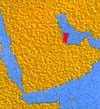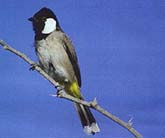Picture by Dr. Mike Hill
 First impressions of Qatar are often made through aircraft windows, looking down upon a sand-coloured peninsula at the wide sweep of Doha Bay with its impressive corniche, and patches of greenery where modern horticulture has converted erstwhile desert to verdant grassy lawns. This birds-eye view of the country's capital city also reveals what many migrating birds have discovered over the last few years: that Arabia's oil-age development offers rich delights for flight weary passengers. For our feathered friends these amount to plentiful drinking water from the numerous swimming pools and garden ponds; a good source of food and more than adequate sleeping quarters in the foliage of bushes and trees that garland the city and its surrounds. For the human visitor, the observant eye picks out modern hotels, marinas, golf course and all the trappings of a comfortable place to take up residence for a while. Once the man and bird have landed however, they tend to go their separate ways - blithely unconcerned about each others lives.
First impressions of Qatar are often made through aircraft windows, looking down upon a sand-coloured peninsula at the wide sweep of Doha Bay with its impressive corniche, and patches of greenery where modern horticulture has converted erstwhile desert to verdant grassy lawns. This birds-eye view of the country's capital city also reveals what many migrating birds have discovered over the last few years: that Arabia's oil-age development offers rich delights for flight weary passengers. For our feathered friends these amount to plentiful drinking water from the numerous swimming pools and garden ponds; a good source of food and more than adequate sleeping quarters in the foliage of bushes and trees that garland the city and its surrounds. For the human visitor, the observant eye picks out modern hotels, marinas, golf course and all the trappings of a comfortable place to take up residence for a while. Once the man and bird have landed however, they tend to go their separate ways - blithely unconcerned about each others lives.
 It is hardly surprising, I suppose, that the jet-lagged business traveller does not consider Qatar's natural attractions as being of prime concern. Despite efforts to develop Qatar as a viable tourism destination, it remains true, as with many other Arabian countries, that the vast majority of visitors go there for work or business rather than purely for leisure purposes. This situation is likely to continue in Qatar and eco-tourism will remain as a minor aspect of the country's overall visitor profile. But this is not to say that Qatar does not have plenty to offer the keen naturalist or dedicated explorer.
It is hardly surprising, I suppose, that the jet-lagged business traveller does not consider Qatar's natural attractions as being of prime concern. Despite efforts to develop Qatar as a viable tourism destination, it remains true, as with many other Arabian countries, that the vast majority of visitors go there for work or business rather than purely for leisure purposes. This situation is likely to continue in Qatar and eco-tourism will remain as a minor aspect of the country's overall visitor profile. But this is not to say that Qatar does not have plenty to offer the keen naturalist or dedicated explorer.
Areas to Visit
Short of time, but keen to learn something of Qatar's fascinating background and natural heritage, the inquisitive visitor could do far worse than to visit Qatar National Museum which is situated within the old fort of Doha. It was one of the first modern museums in Arabia and takes full advantage of its attractive setting, at the water's edge. In addition to excellent geological, fossil, archaeological and traditional displays, the museum houses a well run public aquarium where one can gain a close view of many of the Gulf's sea-creatures. An hour or so spent wandering through the museum will do much to dispel the mistaken notion that Qatar has little to offer the nature-lover.
As with other parts of Arabia, what one gets out of a place is largely dependent upon how much effort one is prepared to put in to exploring it. Nowhere is this more true than with Qatar. Prime time for wildlife watching here is soon after dawn. It definitely pays to rise early and to be out with binoculars by the time that sun rises. If that proves to be too great an effort, then the hour before sunset is also very rewarding.
Away from Doha, the main sites of interest are, moving from north to south, through the peninsula, Al Ruwais and Ras Rakan at the northerly tip of the country where stronger tidal currents bring rich fish life and a productive reef system. The coastline from here around to the magnificent fort at Zubara, has a number of small abandoned villages and is a quiet coastal region where one can find an interesting combination of shorebirds and, in spring and autumn, passage migrants. Moving south along the east coast, the coastal route which hugs the shoreline from Al Ghariyah to Ras Laffan, and then cuts straight through the desert to the large natural harbour at Al Dhakira, is well worth exploring. The region immediately to the south, at Al Khor, has important archaeological sites and the harbour is an active fishing port. Inland, northern Qatar has many irrigated farms which attract birds and other wildlife. A short distance to the west of Doha is the racecourse which is always a good birding site. To the south lies the ancient town of Al Wakrah where some valuable restoration work has taken place on certain buildings. The date gardens of Wakrah attract many small birds including the now ubiquitous, but previously scarce, bulbul.
Close to the southern boundary of Qatar the massive shallow lagoon of Khor Al Udeid is a fascinating place to visit providing one has good four-wheel- drive vehicles. In this vicinity, on the edge of the Empty Quarter, are to be found Qatar's largest sand dunes. The lagoon and its tidal sand flats are a frequent resting place for flamingos and for many other wading birds.
Desert Roses
Desert roses are not flowers but crystals which take the form of rose-petals. A good place to search for them is on the sabkha flats around Umm Said where a particularly characteristic twinned gypsum crystal occurs. Its 'petals' are about 2 cm long and have a shape reminiscent of a swallow's tail. Such crystals are formed when high tides bring seawater into the sabkha and the water becomes cut-off from the sea and evaporates, eventually causing salt deposition and crystal formation. If you do go in search of these strange crystals, be prepared to dig quite deeply beneath the surface.
Fossil Sharks Teeth
Evidence that sharks have been around these shores for a long time can be gathered from the numerous black fossilized sharks teeth that can be collected from the surface of the ground, or else embedded within a yellowish -green shale known as 'Midra shale', found especially along the western side of the peninsula. If you are wondering just how old these sharks teeth are, you would not be far out if you guessed at 50 million years! A long time ago, admittedly, but bear in mind that sharks have been around for eight times as long as that - according to palaeontologists at least as long as 400 million years! Such ruminations aside, the sharks teeth scattered across the surface of Qatar are a reminder that this whole area was once underwater and that the rocks which form it are in fact the remains of marine sediments.
Marinelife
The best place for experiencing marinelife is out from the east and north-east of Qatar, on reefs some distance from shore. Hotels do arrange regular sea-trips when, in addition to snorkelling to admire shallow-water fish, one may also encounter some of the Gulf's marine mammals including humpback and bottlenose dolphins and, if you are very lucky, dugongs. It is also a good way of observing seabirds.
Dugongs
Readers of Arabian Wildlife will already be familiar with the dugong or sea cow: arus el-bahar in Arabic. This shy and elusive marine mammal feeds exclusively on sea grasses and every winter, during February, large numbers of them congregate in the sea area around Qatar. Once thought to be on the verge of extinction, recent helicopter surveys have revealed that over 600 sea cows, including families of parents and their young, may occur in the region. Although they are generally very wary of contact with people, when they are densely aggregated it is possible to approach them quite closely by boat, providing the engine is switched off and one drifts among them. Efforts to photograph dugongs underwater are usually frustrated by relatively poor visibility which is exacerbated by they stir upthe seabed whilst feeding.
Pearling
There are pearl beds all around Qatar and although these are no longer commercially fished, the pearl oysters are still present in great abundance and there is nothing to stop amateur divers having a go at finding that elusive jewel of the sea, the perfect pearl. The Ministry of Information's Press and Publications Division has even produced a chart showing where the pearl beds are. The beautifully produced map plots the position of 206 hayrs or pearl oyster banks, the majority of which are around 30 miles offshore, within the 25 m contour. Clearly diving at these sites requires proper training, experience, guidance and facilities. It does offer a different kind of challenge for those divers who are weary of having nothing to do underwater other than to take photographs, or watch while others take them!
Useful Addresses for Quatar
Arab Gulf States Folklore Centre, PO Box 7996, Doha, Qatar. Tel 861941
Qatar University, Faculty of Science, P O Box 2713, Doha.
Contents | News | Book Reviews | Back Issues | Subjects | Search
Arabian Wildlife. Volume 2, Number 2